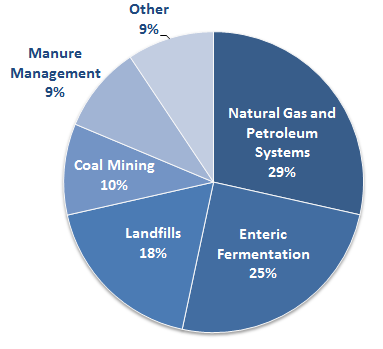Another Way to Milk a Cow
Ask the U.S Environmental Protection Agency about greenhouse gases and one of the items sure to be brought up is methane. Methane is “the second most prevalent greenhouse gas emitted in the United States from human activities [behind carbon dioxide]” per the Agency, accounting for 9% of the total annual human-controlled emissions. You may even be shown the graph below, which the EPA has on its info page about methane.

Just under 30% comes from our efforts to obtain natural gas and oil, but coming in at number two is something called “enteric fermentation.” A quick jump to Wikipedia explains:
Enteric fermentation occurs when methane (CH4) is produced in the rumen as microbial fermentation takes place. Over 200 species of microorganisms are present in the rumen, although only about 10% of these play an important role in digestion. Most of the CH4 byproduct is belched by the animal, however, a small percentage of CH4 is also produced in the large intestine and passed out as flatulence.
So what’s a rumen? It’s a multi-chambered stomach, an organ found in deer, camels, and of particular note, cows. In short: a large chunk of methane emissions comes from cows, living and eating on our farms (so we can have milk and cheese and hamburgers and steaks), and ultimately, passing gas or burping.
That’s the bad news. The good news is that methane isn’t just some evil specter which is slowly killing the Earth — it’s actually useful, if captured. If your home or business is heated using natural gas, the “natural gas” we’re talking about is actually comprised mostly of methane, carried into these buildings through massive gas pipelines. Storing methane is difficult, though; it needs to be cooled down to very low temperatures or highly pressurized, as NBC News describes, and both of these methods “require large amounts of energy and can be dangerous and flammable.” (But as the NBC News piece notes, we’re working on other solutions.) Further, at normal conditions, methane is an odorless, colorless gas. So when it comes to cow burps, even detecting the methane is task unto itself.
But Argentina may have found a way to capture that cow-created methane — by bagging it in specially-made cow backpacks, catching the gas before the cattle otherwise express it.
The invention sounds ridiculous but cow flatulence is no joke. Fast Company explained in an article featuring a few pictures of the backpack-wearing cows. In the (very experimental) prototype, a tube is inserted into the rumen itself. That tube leads the methane directly into the backpack. As much as 80 gallons (300 liters) of methane can be collected in this way per cow, per day. (The article notes that 80 gallons of methane would yield enough electricity to power a refrigerator for a day, which, if you think about it, means a cow could keep its own milk from spoiling.)
Unfortunately, whether it has long-term benefits is something we’ll have to wait a while to find out. The Argentine agency behind the experiment sees it as a proof-of-concept and they aren’t carrying out further tests with the device currently. Eighty gallons of methane has a market value of only a few cents, making the project an economic non-starter for the time being. However, the environmental gains — turning greenhouse emissions into useable energy — may lead to a use in the future.
Bonus Fact: Above, you may have noticed that methane (and natural gas) is said to be odorless — which, if you’ve ever smelled a gas stove or any other pipeline with natural gas coming out of it, may surprise you. Natural gas, at least in one’s home, isn’t odorless and, in fact, has a very distinct smell. That’s because most commercial gas distributors add something called mercaptan to the mix. It’s added to signal danger — gas customers get an olfactory warning when a leak may be present — but isn’t a natural characteristic of the gas.
From the Archives: Cow Magnets: Something else science sticks in a cow’s rumen.
Related: “Cows Save the Planet: And Other Improbable Ways of Restoring Soil to Heal the Earth” by Judith D. Schwartz. 4.5 stars on 45 reviews.
